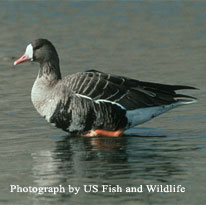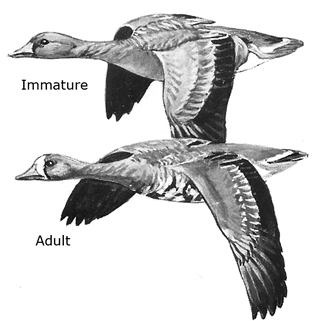Wildlife - Species

Species Specific Regulations
White-Fronted Geese
Licenses: Hunting License required. Migratory Bird Hunting and Conservation Stamp (Federal Duck Stamp) that is validated by the hunter signing the stamp in ink across the face of the stamp
Limits: Please see Migratory Bird Regulations for any game zones restrictions or Limitations.
White-Fronted Geese (Anser albifrons)

Description
The white-fronted goose has a brownish gray at body and a white forehead and base of the orangeish bill. They are often called "specklebelly" due to the black mottling on the belly.
Average Size
White-fronted geese have an average length of 29 inches and an average weight of 6 1/4 pounds.
Preferred Habitat
White-fronted geese spend the breeding season concentrated along the Y-K Delta meltwater areas, slough banks, and river edges near the Bering sea. In the winter months they are found in open water, unvegetated shores, and agricultural crops.
Food Habits
During the breeding season these geese usually consume sedges, grasses, berries, and underground plant parts. In the winter they usually consume seeds, grains, and grasses.
Reproduction
Pair bonds are initially formed during the second summer as yearlings on the nesting or molting areas. Once the pair is ready to nest, the female creates a nest scrape near water in densely vegetated areas and incorporates the vegetation from near the nest into it. She then lays 1-8 creamy white eggs.
Sound
High pitched call kow-kow-kow-kow.
Behavior
- Males are territorial on the breeding grounds.
- Family bonds persist longer than in other geese, young may even remain with parents into the next breeding season where they help defend the nest.
Citations, Publications and Literature
U.S. Fish & Wildlife Service, Federal Duck Stamp Office Presents: North American Waterfowl (Adobe PDF file)
Ely, C. R. and A. X. Dzubin. 1994. Greater White-fronted Goose (Anser albifrons), The Birds of North America Online (A. Poole, Ed.). Ithaca: Cornell Lab of Ornithology; Retrieved from the Birds of North America Online
South Carolina waterfowl hunters 16 and older are required by state law to obtain a state migratory waterfowl permit and Migratory Game Bird permit. Both permits must be in the hunter's possession while hunting or transporting legal waterfowl. A state waterfowl permit is included with the Lifetime Senior, Lifetime Gratis and Disability Licenses. S.C. residents who hold a Lifetime Senior or Lifetime Gratis License are not required to have a Migratory Game Bird permit.
National Migratory Bird Harvest Information Program (HIP)
The waterfowl permits and HIP permits are available from select DNR offices and from hunting and fishing license agents.
